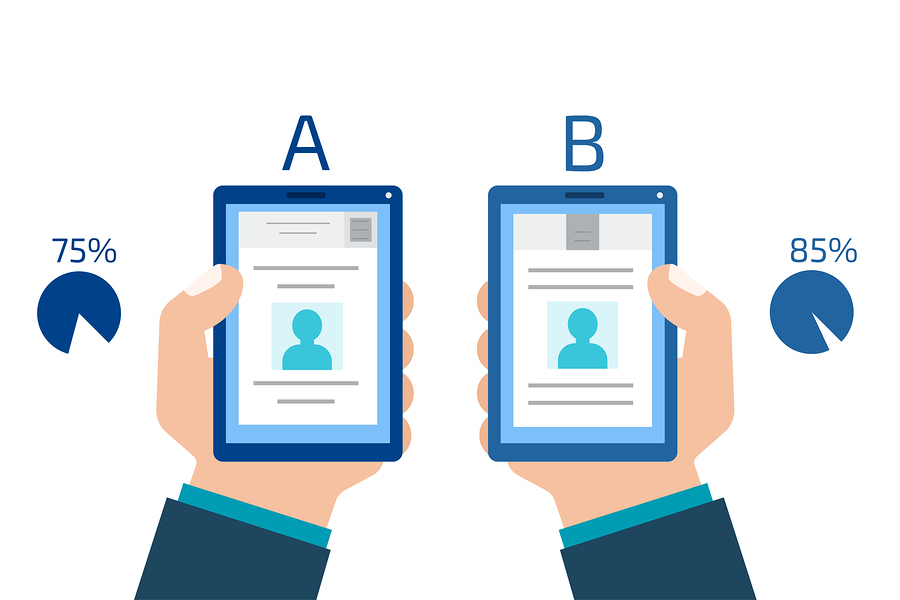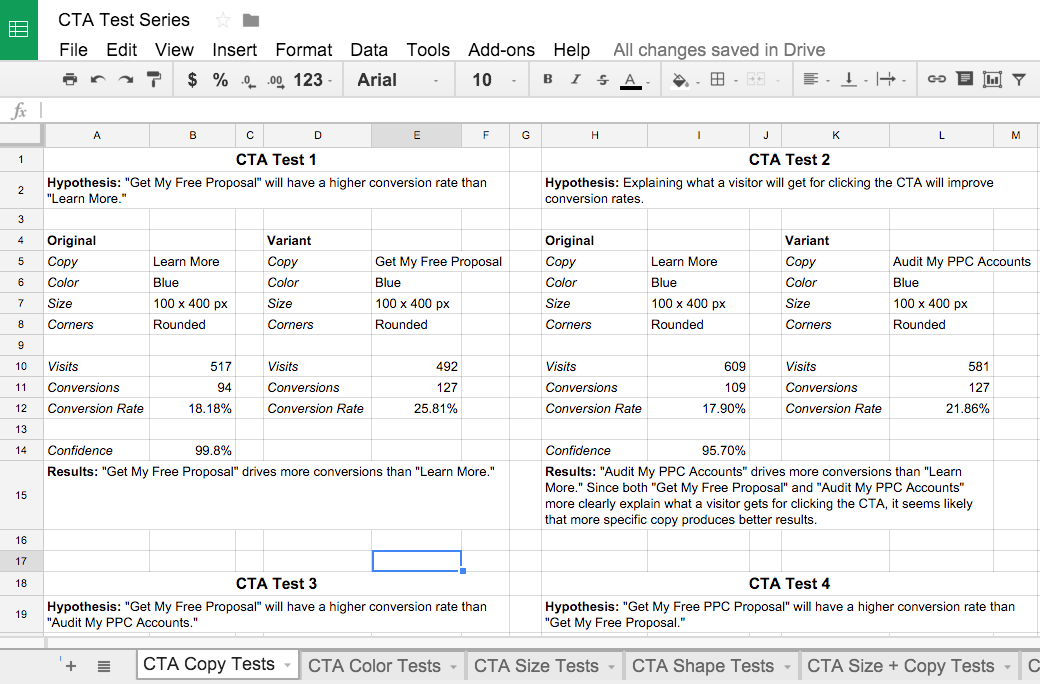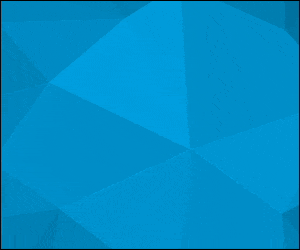Marketing, unfortunately, isn’t an exact science. Nor is there ever a “one size fits all” solution to business objectives. There are hundreds of best practices when it comes to marketing, but sometimes those best practices aren’t the best fit for the goals you’re looking to achieve. To make sure you’re driving the strongest results, you need to test! You can’t optimize for the best results for what you don’t test.
At Bluetext, we are big advocates of A/B testing; we use the tactic across different marketing initiatives – from landing pages, email templates, call-to-actions, banner ads, and everything in between. And by hiring a marketing analytics agency, you can eliminate the guesswork around what tactics are the best fit for your business needs.

What is A/B Testing?
A/B Testing (also known as split testing) is a simple and effective tactic to use when you want to understand your audience better and improve overall campaign performance. A/B testing is an experiment where two (or more) variants of a specific asset are shown to users at random, and statistics help to determine which variant performs better for achieving your ultimate goal. Users start off with a control asset, and then run a variant alongside the control, measuring results accordingly. Sound familiar? It’s the exact same concept of scientific method you learned in primary school! The only difference is you can turn these stats into real business revenue, not a lab report.
A/B testing takes the assumptions and the ‘best practices’ out of the equation. Marketing, as we mentioned, isn’t an exact science; we don’t know what we don’t know! A/B testing relies on statistical data to help marketers understand and verify what resonates best with their audience.

How A/B Testing Works
A/B testing can be executed in several ways. If you’re running a display ad campaign and want to test animated ads vs. static ads, then perhaps you don’t necessarily have a ‘control.’ You launch both variants at the same time, and once you collect enough data for the test to be statistically significant, you pause the under-performing ad variant.
Alternatively, you may want to improve your landing page conversion rates. In this case, you take your current landing page environment – the control – and change one asset on the landing page; this page becomes your variant. The popular heatmapping landing page tool, Crazy Egg, notes that A/B testing landing pages is useful because it “lets you see what elements really click with your audience and which don’t. Changing just one word in your CTA can reveal nuances about your target audience that you never would have otherwise discovered.”
After your test has reached statistical significance, you have the tools needed to determine whether you should continue to keep your control landing page live, or if you should redirect all traffic to your new landing page.
The most beneficial aspect of A/B testing is that you will receive results: you will end an A/B test with a clear winner, and insights into what resonates more with your audience, arming you with the tools you need to improve your marketing performance.

You Have A Winner! Now What?
Once your test has run its course by reaching statistical significance, and you have a clear winner, what’s next?
Implementation to start! Don’t waste any more time – or money – driving users to a lower-converting landing page, or showing underperforming ads to your audience. Take the winner of your A/B test, apply it, and start to see your KPIs skyrocket.
Of course, testing is a marathon, not a sprint. Just because you tested one asset, there are still hundreds – thousands – of other tests you could (and should) run. A/B testing should be an ongoing tactic for your marketing efforts, not a one-and-done completion. Remember: you can’t optimize what you don’t test.

When determining what your next A/B test should be, make sure you’ve analyzed your most recent test, and understand why the winner actually won. What did you learn? Did a new call-to-action boost conversion rate? What did you change in your CTA, and why do you think that minor change helped to increase your conversion rate? If the CTA on that landing page helped to increase conversions, where else could you apply this change?
It’s critical to take time to ask yourself these small questions to help understand the bigger picture. Chances are, you will come away from your latest test analysis understanding your target audience even better, and will have an idea for your next big A/B test.
One thing we can’t stress enough: document your A/B tests! Document the setup, the control and variant, the winner, your analysis – everything. Save it in a safe place. As Medium states, documenting your tests “leads to deeper understanding and context. In turn, that understanding sparks new ideas causes stronger hypotheses, and prevents running similar tests twice.” You will absolutely want to reference previous A/B test documents before jumping into the next!

Now that you have an idea of what A/B testing is, how to approach it, and how to expand on your learnings – what will be your next (or first!) A/B test? Learn how Bluetext has helped clients achieve stronger KPIs and boost conversion rates through strategic A/B testing on our site.
Programmatic Advertising – No Signs of Slowing Down in 2020
If you spend any time at all surfing the web, you have encountered some form of programmatic advertising. The video ad that plays before you stream your favorite TV show? Programmatic. The banner ad that appears alongside the cooking recipe you’re reading? Programmatic. The sponsored article content that shows up as you’re scanning your favorite news site? You guessed it – it’s programmatic.
Programmatic Advertising – What is it?
Programmatic ad buying is the use of software to purchase digital advertising in real-time, as opposed to the traditional ad buying process that involves RFPs, human negotiations, and manual insertion orders. It allows digital agencies like Bluetext to strategically select where we want to show display, video and native ads, and when.
A huge benefit of programmatic advertising is that the software grants advertisers access to the biggest data providers in the game. Not only are we choosing where and when to show ads online, but we have the capabilities to choose who actually sees our ads. Advertisers are able to hand-select from thousands of audience segments collected by these data providers and layer those segments onto programmatic campaigns.

Why Invest in Programmatic?
While targeting capabilities and ease-of-use are two major benefits of investing in programmatic advertising, there are a number of reasons why digital agencies should hop on the programmatic bandwagon in 2020.
Here are Bluetext’s top 3 reasons for investing in programmatic advertising in 2020:
1. Artificial Intelligence (AI) and Machine Learning
Programmatic advertising already makes digital ad buying easier for advertisers than it ever was before, but AI and machine learning have simplified the process even more. For years, media buyers and digital marketers relied on a manual process to review campaigns, manage budgets, make adjustments to ad creative, and more. However, AI and machine learning have become so sophisticated that the manual days of optimizing are nearly over. Once your campaign has launched, the AI will start to learn what’s working and what’s not, shifting budgets and making adjustments to enhance efficiency in real-time. Studies show that by 2035, AI will boost productivity and profitability by nearly 40%.
As a leading digital marketing agency, Bluetext has seen the benefits of AI and machine learning pay off in major ways. Not only is our digital marketing team more efficient, but the results we were able to drive for clients in 2019 far exceeded their goals. With AI and machine learning only becoming smarter, Bluetext is equipped to reach new heights with programmatic advertising in 2020.
2. Digital Out of Home (DOOH) Opportunities
Digital Out of Home (DOOH) advertising is a unique marketing channel that allows advertisers to reach users outside of their homes in digitally-displayed spaces. Though DOOH media isn’t new, it’s expected to grow exponentially in the coming years. Reports show that between 2016 and 2023, the DOOH media channel will grow from $3.6 Billion to $8.4 Billion.
With the average person spending 70% of their time outside of their home, investing in DOOH in 2020 is a no-brainer. From mobile geofencing to digital billboards, the opportunities to reach people on-the-go are vast. Most importantly, because DOOH is now offered through programmatic platforms, advertisers will have access to significantly more data from DOOH advertising than ever before.
Digital marketing agencies like Bluetext now have the ability to measure results from a digital billboard ad or an animated kiosk through the data and technology programmatic tools provide. Bluetext is looking forward to expanding DOOH capabilities in 2020 to connect the dots from in-home browsing to in-store purchasing.
3. Multi-Channel Advertising
In the past, advertising agencies had to leverage several different platforms, media vendors and direct buys to ensure they reached their audiences across all mediums. Programmatic advertising has simplified this process so that marketing agencies like Bluetext can execute all advertising efforts through one simple-to-use platform.
Programmatic solutions include paid social, display, video pre-roll, native advertising, geofencing, DOOH, connected TV and more. Digital marketing agencies like Bluetext now have the capability to run one digital campaign across all different mediums and – most importantly – track user behavior across all touchpoints. With AI and machine learning, programmatic campaigns will optimize to reach users at the right time on the right medium, whether that’s on the computer, on their smart TV, or in a store on their mobile device. In 2020, it’s expected that even more multi-channel solutions will be announced, such as voice-activated ads powered through devices like Alexa and Siri.

Programmatic advertising has opened the door for digital marketing agencies like Bluetext to effectively run and execute campaigns across a number of channels and mediums, making media dollars more efficient than ever before. With the expansion of programmatic solutions in 2020, there’s no limit to the number of possibilities Bluetext will be able to leverage to drive digital media success for our clients. To learn more about our work with programmatic advertising contact us.
Do you remember when you used to have to consult books and encyclopedias for the answers to your questions? Just over 20 years ago, you had to reference the yellow pages to find a marketing agency. Nowadays, Google is the search engine king, the go-to for 73% of searches online (and 81% of mobile search). Top marketing agencies depend on Google and it’s algorithms to direct current and potential customers to their clients’ sites via both organic and paid search.
What’s the difference between non-organic and organic (search)?
Organic search is the result of entering search terms as a single string of text into a search engine. Organic search results appear as lists that are based on relevance to the search terms and exclude advertisements; they do not filter out pay-per-click advertising. Paid search is a form of digital marketing where search engines like Google and Bing allow advertisers to show ads at the top of search engine results pages (SERPs). Paid search operates on a pay-per-click model– meaning there is no cost until someone clicks on your ad or content.
Organic traffic is widely considered the most valuable traffic source for multiple reasons:
- They are the most trusted source for people researching a purchase.
- Google’s algorithms and rankings are very sophisticated — ranking in the top five results for a keyword indicates that your content is high quality.
- Results on the first page of Google (The Top 10) receive 92% of all search traffic on Google. Traffic drops 95% on the second search page.
- 33% of clicks from organic search occur on the first listing on Google.
The downside to organic search is that it takes time to get indexed and generate traffic. Although evergreen content ranks higher than paid (time-limited) placements, the lag in rank visibility may not work for every business case.
Rev up your (search) engines with a paid approach
Besides considering how much traffic will reach a site via organic or paid search, top marketing agencies also work with their clients to enhance their performance with search engine algorithms through search engine optimization (SEO). Improving your company’s search engine optimization isn’t just about the politics of appearing first, it carries financial benefits, too — 57% of B2B marketers say SEO is the biggest factor impacting lead generation.
To optimize your site rank in the organic search results, you need to employ SEO techniques to make your page as crawlable as possible to search engine algorithms. This includes using keywords in critical real estate (headers, links) and including content that relates to those key search terms.
Paid searches are the companies that have paid to appear at the top of your search engine. Even with the little yellow disclaimer “Ad” box, many users click intuitively on these paid placements. Rather than having to wait patiently for your SEO to build up through indexing, you can pay for the chance to get seen on page one of Google immediately.
You can put your money where your mouth is, or play the long SEO game
Sometimes paid search isn’t in a company’s budget – fear not, having the deepest pocket does not ensure SEO success. Google has processes in place (quality score, copy rules, landing page quality, and more) to make sure that the ads that rank are still highly relevant for searchers. Investing substantial budget in ads or paid search will only float a company so far in the ranking algorithms if their content isn’t crafted to support these buys. In both organic and paid search, Google puts user experience first, which is why top marketing agencies such as Bluetext focus on a holistic approach to SEO, creating high-quality evergreen content that ensures both organic and paid efforts are supported through continuous search engine indexing. Digital marketing agencies are experienced at selecting organic keywords that will be both effective and realistic, and they provide support in creating a strong content base to perform in SERPs.
See how Bluetext can help improve your SEO »
October 26, 1994 is a day that will be forgotten by few…it was the first day a banner ad (or any ad for that matter) was posted on the internet. AT&T paid $30,000 for the appearance of the first banner ad. While we have seen an explosion in the variety of ad types on the internet since then, banner ads still remain among the most popular. Banner ads are rectangular displays that appear on web pages but can vary in appearance, theme, and content. Even though banner ads may seem like a rudimentary advertising technique, they are still an incredibly useful tactic used by brands across the world. Here are four reasons why Bluetext believes banner ads are still an asset to any company.
-
Banner Ads Can Have Different Presentation Elements
Nowadays, banner ads are just downright pretty. Thanks to the evolution of graphic design, banner ads can include elements such as graphics, video, audio, and everything in between. As the world of paid media continues to grow, banner ads have evolved alongside. In recent years, it has become evident that animated banner ads are far more effective – and engaging – than static ads. In fact, animated banner ads can help increase conversion by up to 73%. The catch, however, is that animated banner ads are not easy to produce without a team of animators, especially with normal file sizing in mind. Luckily, a branding agency such as Bluetext has an experienced creative team, which proved helpful when the Graduate Management Admission Council (GMAC) needed help with a brand redesign. Part of this redesign included a new media campaign that presented personalized content through captivating visuals, engaging messaging, and efficient audience septation; in short, it helped ensure that the right message was going to the right person at the right time. As a result, GMAC saw a 153% increase in website content clicks and 400,000 more microsite visitors.

-
Banner Ads Increase Awareness of Your Brand and Products
While banner ads may be helpful in driving immediate sales, they also play a larger role in building brand recognition, which is vital when internet users don’t immediately click on an ad. Studies have shown that banner ads are a great way to keep your brand top-of-mind when it comes time for a customer to buy your product, which is helpful considering 73% of internet users in the United States over the age of 14 buy products online. Additionally, even though web users may not be directly looking or focusing on your ads, they will be subconsciously exposed to your brand and products through banner ads. While the ultimate goal is to drive sales, banner ads are a fantastic way to keep your company, your brand, and your products on the minds of consumers.

-
Banner Ads are Easily Measurable
One of the most beneficial aspects of modern-day advertising is our ability to measure the successes of the campaigns a company like Bluetext can help you run. Thanks to programs such as Google Ads and Google Analytics, we can measure data points that tell us how many people saw your ad, how many people clicked on your ad, how many people made a purchase after viewing your ad, and so much more. With help from these tools, we know the average click-through-rate for a banner ad is 0.07%. While this number may seem low, it is necessary to recognize that it has a higher action rate than billboard (.03%) and television (.05%) ads.

-
Banner Ads Support Retargeting
Have you ever put an item in your shopping cart and let it sit, only to see ads for that same product pop up all over your web pages? This tactic is referred to as ‘retargeting,’ which helps drive users to complete their orders (or other low-funnel action). Studies have shown that users who are exposed to retargeting banner ads are 70% more likely to complete the desired action. If that isn’t convincing enough, remember how we said the average click-through-rate for a banner ad is 0.07%? Well, the average click-through-rate for a retargeting banner ad is 0.7%, 10 times the amount!
Clearly, banner ads, especially animated ads, have their pros. With some of those pros in mind, it is vital to remember a few key tips when running a banner ad campaign. First, update your ads! Click-through-rate decreases by nearly 50% after running the same group of ads for five months. Secondly, as only 8% of customers return to their cart to finish a transaction without retargeting, it is vital to allocate some of your advertising budget to retargeting campaigns. Lastly, don’t get discouraged if your banner ads have a low click-through-rate. Other metrics, such as impressions, can show us how many people have seen the ad, even if they haven’t clicked on it. In short, banner ads are a key advertising method to drive sales and boost brand awareness. While banner ads are great alone, they are most effective when paired with other types of advertising techniques, such as paid search.

